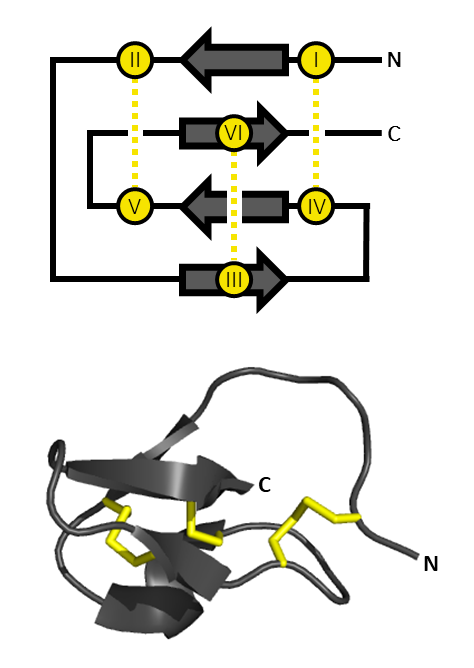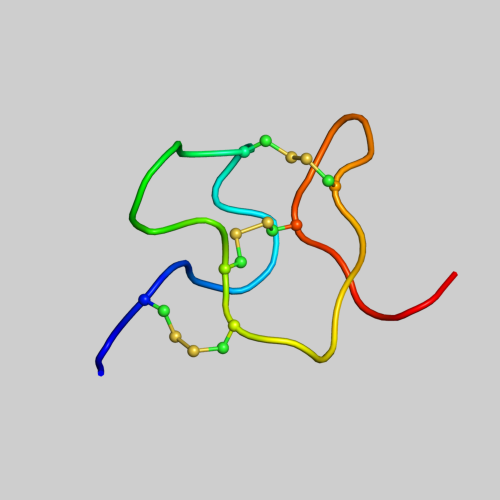|
TLTx
Theraphosa leblondi toxin (TLTx) is a toxin occurring in three different forms (subtypes) that are purified and sequenced from the venom of the giant tarantula ''Theraphosa blondi''. This toxin selectively inhibits Kv4.2 voltage-gated potassium channels by acting as a gating modifier. Sources The toxin is a component of the venom of the Goliath bird-eating spider '' Theraphosa leblondi''. Chemistry TLTx is part of the family of Kv4-specific tarantula toxins, which are short peptides with a disulfide-bonded core domain. Other members of this family are heteropodatoxins and phrixotoxins. Three homologous peptides (TLTx1, 2 and 3) have been isolated from the venom of the tarantula. They consist of 35 amino acids, with a mass of <5 kDa. They form a total of 3 disulfide bonds between the side chains of cysteine, of which the positions in the sequence are identical in all subtypes of the toxin. The homology with other tarantula toxins suggests that TLTx also forms and |
TLTx Disulfide Bonds
Theraphosa leblondi toxin (TLTx) is a toxin occurring in three different forms (subtypes) that are purified and sequenced from the venom of the giant tarantula ''Theraphosa blondi''. This toxin selectively inhibits Kv4.2 voltage-gated potassium channels by acting as a gating modifier. Sources The toxin is a component of the venom of the Goliath bird-eating spider '' Theraphosa leblondi''. Chemistry TLTx is part of the family of Kv4-specific tarantula toxins, which are short peptides with a disulfide-bonded core domain. Other members of this family are heteropodatoxins and phrixotoxin Phrixotoxins are peptide toxins derived from the venom of the Chilean copper tarantula ''Phrixotrichus auratus'', also named ''Paraphysa scrofa''. Phrixotoxin-1 and -2 block A-type voltage-gated potassium channels; phrixotoxin-3 blocks voltage-g ...s. Three homologous peptides (TLTx1, 2 and 3) have been isolated from the venom of the tarantula. They consist of 35 amino acids, with a mass of <5 k ... [...More Info...] [...Related Items...] OR: [Wikipedia] [Google] [Baidu] |
TLTx
Theraphosa leblondi toxin (TLTx) is a toxin occurring in three different forms (subtypes) that are purified and sequenced from the venom of the giant tarantula ''Theraphosa blondi''. This toxin selectively inhibits Kv4.2 voltage-gated potassium channels by acting as a gating modifier. Sources The toxin is a component of the venom of the Goliath bird-eating spider '' Theraphosa leblondi''. Chemistry TLTx is part of the family of Kv4-specific tarantula toxins, which are short peptides with a disulfide-bonded core domain. Other members of this family are heteropodatoxins and phrixotoxins. Three homologous peptides (TLTx1, 2 and 3) have been isolated from the venom of the tarantula. They consist of 35 amino acids, with a mass of <5 kDa. They form a total of 3 disulfide bonds between the side chains of cysteine, of which the positions in the sequence are identical in all subtypes of the toxin. The homology with other tarantula toxins suggests that TLTx also forms and |
Inhibitor Cystine Knot
An inhibitor cystine knot (aka ICK or Knottin) is a protein structural motif containing three disulfide bridges. Knottins are one of three folds in the cystine knot motif; the other closely related knots are the Growth Factor Cystine Knot (GFCK) and the Cyclic Cystine Knot (CCK; cyclotide). Types include a) cyclic mobius, b) cyclic bracelet, c) acyclic inhibitor knottins. Cystine knot motifs are found frequently in nature in a plethora of plants, animals, and fungi and serve diverse functions from appetite suppression to anti-fungal activity. Along with the sections of polypeptide between them, two disulfides form a loop through which the third disulfide bond (linking the 3rd and 6th cysteine in the sequence) passes, forming a knot. The motif is common in invertebrate toxins such as those from arachnids and molluscs. The motif is also found in some inhibitor proteins found in plants, but the plant and animal motifs are thought to be a product of convergent evolution. The ICK moti ... [...More Info...] [...Related Items...] OR: [Wikipedia] [Google] [Baidu] |
Tarantula
Tarantulas comprise a group of large and often hairy spiders of the family Theraphosidae. , 1,040 species have been identified, with 156 genera. The term "tarantula" is usually used to describe members of the family Theraphosidae, although many other members of the same infraorder (Mygalomorphae) are commonly referred to as "tarantulas" or "false tarantulas". Some of the more common species have become popular in the exotic pet trade. Many New World species kept as pets have setae known as urticating hairs that can cause irritation to the skin, and in extreme cases, cause damage to the eyes. Overview Like all arthropods, the tarantula is an invertebrate that relies on an exoskeleton for muscular support.Pomeroy, R. (2014, February 4). Pub. Real Clear Science, "Spiders, and Their Amazing Hydraulic Legs and Genitalia". Retrieved October 13, 2019, from https://www.realclearscience.com/blog/2013/02/spiders-their-amazing-hydraulic-legs-and-genitals.html. Like other Arachnida, ... [...More Info...] [...Related Items...] OR: [Wikipedia] [Google] [Baidu] |
Goliath Birdeater
The Goliath birdeater (''Theraphosa blondi'') belongs to the tarantula family Theraphosidae. Found in northern South America, it is the largest spider in the world by mass () and body length (up to ), and second to the giant huntsman spider by leg span. It is also called the Goliath tarantula or Goliath bird-eating spider; the practice of calling theraphosids "bird-eating" derives from an early 18th-century copper engraving by Maria Sibylla Merian that shows one eating a hummingbird. Despite the spider's name, it rarely preys on birds. Physical description These spiders can have a leg span up to , a body length of up to and can weigh up to .Goliath Bird-Eating Spider , Arkive Birdeaters are one of the few tarantula species that lack tibial spurs, located on the first pair of legs of mos ... [...More Info...] [...Related Items...] OR: [Wikipedia] [Google] [Baidu] |
KCND2
Potassium voltage-gated channel subfamily D member 2 is a protein that in humans is encoded by the ''KCND2'' gene. It contributes to the cardiac transient outward potassium current (Ito1), the main contributing current to the repolarizing phase 1 of the cardiac action potential. Description Voltage-gated potassium (Kv) channels represent the most complex class of voltage-gated ion channels from both functional and structural standpoints. Their diverse functions include regulating neurotransmitter release, heart rate, insulin secretion, neuronal excitability, epithelial electrolyte transport, smooth muscle contraction, and cell volume. Four sequence-related potassium channel genes - shaker, shaw, shab, and shal - have been identified in Drosophila, and each has been shown to have human homolog(s). This gene encodes a member of the potassium channel, voltage-gated, shal-related subfamily, members of which form voltage-activated A-type potassium ion channels and are prominent in the ... [...More Info...] [...Related Items...] OR: [Wikipedia] [Google] [Baidu] |
Theraphosa Leblondi
The Goliath birdeater (''Theraphosa blondi'') belongs to the tarantula family Theraphosidae. Found in northern South America, it is the largest spider in the world by mass () and body length (up to ), and second to the giant huntsman spider by leg span. It is also called the Goliath tarantula or Goliath bird-eating spider; the practice of calling theraphosids "bird-eating" derives from an early 18th-century copper engraving by Maria Sibylla Merian that shows one eating a hummingbird. Despite the spider's name, it rarely preys on birds. Physical description These spiders can have a leg span up to , a body length of up to and can weigh up to .Goliath Bird-Eating Spider , Arkive Birdeaters are one of the few tarantula species that lack tibial spurs, located on the first pair of legs of m ... [...More Info...] [...Related Items...] OR: [Wikipedia] [Google] [Baidu] |
Heteropodatoxin
Heteropodatoxins are peptide toxins from the venom of the giant crab spider ''Heteropoda venatoria'', which block Kv4.2 voltage-gated potassium channels. Sources Heteropodatoxins are purified from the venom of the giant crab spider, ''Heteropoda venatoria'' . Chemistry Heteropodatoxins contain an Inhibitor cystine knot, Inhibitor Cystine Knot (ICK) motif, which consist of a compact disulfide-bonded core, from which four loops emerge . There are three different heteropodatoxins : * heteropodatoxin-1, also known as Toxin AU3/KJ5 or HpTx1 * heteropodatoxin-2, also known as Toxin KJ6 or HpTx2 * heteropodatoxin-3, also known as Toxin AU5C/KJ7 or HpTx3 These three toxins are structurally similar peptides of 29-32 amino acids . They show sequence similarity to Hanatoxins, which can be isolated from the venom of the Chilean rose tarantula Grammostola rosea . Target Heteropodatoxins block A-type, transient voltage-gated potassium channels. All three toxins have been shown to bloc ... [...More Info...] [...Related Items...] OR: [Wikipedia] [Google] [Baidu] |
Phrixotoxin
Phrixotoxins are peptide toxins derived from the venom of the Chilean copper tarantula ''Phrixotrichus auratus'', also named ''Paraphysa scrofa''. Phrixotoxin-1 and -2 block A-type voltage-gated potassium channels; phrixotoxin-3 blocks voltage-gated sodium channels. Similar toxins are found in other species, for instance the Chilean rose tarantula. Sources Phrixotoxins are purified from the venom of the spider ''Phrixotrichus auratus'' , but they can also be produced by chemical peptide synthesis . Structure There are three different phrixotoxins: *Phrixotoxin-1 (PaTx1) – which is composed of 29 amino acids *Phrixotoxin-2 (PaTx2) – which is composed of 31 amino acids *Phrixotoxin-3 (PaurTx3 or Beta-theraphotoxin-Ps1a) – which is composed of 34 amino acids PaTx1 is 83.3% identical to PATx2, differing only by two acidic residues. Phrixotoxin-1 and -2 are similar to heteropodatoxin, which also has a blocking activity on Kv4.2 channels . Phrixotoxin-1, -2 and -3 contain an ... [...More Info...] [...Related Items...] OR: [Wikipedia] [Google] [Baidu] |
IC50
The half maximal inhibitory concentration (IC50) is a measure of the potency of a substance in inhibiting a specific biological or biochemical function. IC50 is a quantitative measure that indicates how much of a particular inhibitory substance (e.g. drug) is needed to inhibit, ''in vitro'', a given biological process or biological component by 50%. The biological component could be an enzyme, cell, cell receptor or microorganism. IC50 values are typically expressed as molar concentration. IC50 is commonly used as a measure of antagonist drug potency in pharmacological research. IC50 is comparable to other measures of potency, such as EC50 for excitatory drugs. EC50 represents the dose or plasma concentration required for obtaining 50% of a maximum effect ''in vivo''. IC50 can be determined with functional assays or with competition binding assays. Sometimes, IC50 values are converted to the pIC50 scale. :\ce = -\log_ \ce Due to the minus sign, higher values of pIC50 indica ... [...More Info...] [...Related Items...] OR: [Wikipedia] [Google] [Baidu] |
Ion Channel Toxins
An ion () is an atom or molecule with a net electrical charge. The charge of an electron is considered to be negative by convention and this charge is equal and opposite to the charge of a proton, which is considered to be positive by convention. The net charge of an ion is not zero because its total number of electrons is unequal to its total number of protons. A cation is a positively charged ion with fewer electrons than protons while an anion is a negatively charged ion with more electrons than protons. Opposite electric charges are pulled towards one another by electrostatic force, so cations and anions attract each other and readily form ionic compounds. Ions consisting of only a single atom are termed atomic or monatomic ions, while two or more atoms form molecular ions or polyatomic ions. In the case of physical ionization in a fluid (gas or liquid), "ion pairs" are created by spontaneous molecule collisions, where each generated pair consists of a free electron and a ... [...More Info...] [...Related Items...] OR: [Wikipedia] [Google] [Baidu] |






